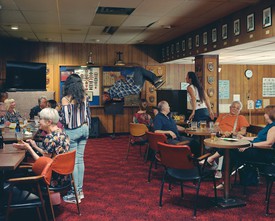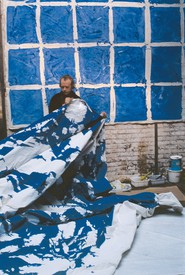
Clare McAndrew is a cultural economist specializing in the arts, antiques, and collectibles markets. In 2005, she founded the Dublin-based firm Arts Economics, which works with a network of private consultants and academic scholars to provide art-market research, analysis, and consulting services to the global art trade and financial sector.

Alison McDonald is the Chief Creative Officer at Gagosian and has overseen marketing and publications at the gallery since 2002. During her tenure she has worked closely with Larry Gagosian to shape every aspect of the gallery’s extensive publishing program and has personally overseen more than five hundred books dedicated to the gallery’s artists. In 2020, McDonald was included in the Observer’s Arts Power 50.
Alison McDonaldWhat do you see as the core elements of the art ecosystem?
Clare McAndrewWell, as an economist, I look at supply and demand as the fundamental components. Supply is represented by artists and demand is represented by collectors and patrons of the arts. But my research often tends to focus on everybody in between, all the different intermediaries.
When I first started doing my Art Basel annual art-market report, many years ago, things were simpler: the intermediaries were galleries, dealers, auction houses, and fairs, and that was it. Now there are press agencies, advisors, online initiatives that work with galleries and auction houses, or directly with consumers and artists, and on—a wide range of platforms. The number of intermediaries focused on sales alone has expanded substantially. And then there are all of the information intermediaries—there have always been critics and media, but now there are data providers, financial art advisors, a whole advisory network, and that’s before you even look at events and all the different businesses and experts attached to them.
Something I’ve looked at in my research for institutional clients is the wider economic impact of the art market, and then you get a sense of all the ancillary and side businesses that support it—they’re in the ecosystem, they’re all the support services, logistics, insurance, banking, all those things that are often very niche, specialized services. Some of them wouldn’t exist at all without the art market, such as the specialized appraisers and conservators, but there are also specialized areas of mainstream industries like insurance and banking.
One very important intermediary is the government, which can be a little bit of a double-edged sword. On the one hand, the government is a consumer and a supporter of the arts and a very important funder and protector. On the other hand, it has a role in direct and indirect regulation of the art trade, and that doesn’t always have a positive impact. So you have all these systems that interact together, and it’s expanding.
AMcDIt’s fascinating to think about the different roles that governments can play, both directly and indirectly. Perhaps you could elaborate on that, or provide an example?
CMcAThey’re very important. They can provide aid directly, for example by offering subsidies for artists, or they can impact the market indirectly—how they tax the wealthy can stimulate or suppress sales, and regulations that they impose can restrict art exports. So they can be positive or negative. When I started researching the art market, my focus was on artists—I was working for arts councils back then, to suggest ways the government could better support artists’ livelihoods and careers. Some of that research showed how policies can be put into place that won’t necessarily have the impact that the government thinks they will. At the time, governments were looking for alternatives to direct subsidies, but in hindsight we’ve found out that, in a lot of ways, policies like subsidies, which drive supply and encourage a healthy, thriving market, actually work better than trying to interfere with the market’s prices and other mechanisms.
AMcDWhat do you see as submarkets? And what role do auctions, art fairs, and private sales play in the marketplace?
CMcAThey’re all fundamental parts of the market. Private sales have grown considerably since I first started looking at the market. The public-auction sector has had a couple of years of double-digit declines, and even without that it’s become a smaller element overall, but auctions are still fundamentally important as the public barometer of value in the marketplace. Fairs are also critical because they allow galleries to collaborate and rival the one-room excitement that you can get at an auction.
What makes the submarkets for art really interesting is the relationship between the primary and the secondary markets, because it’s so different from other industries. The primary market, where galleries and artists interact, is generally a high-risk, uncertain market because the works are of variable quality and less information is available about a lot of artists operating in it. Then in the secondary market, where most of the art trade is in terms of value, there’s more information, quality has been established, and prices have tended to rise over time. This is totally different from other industries, where it’s typically the opposite: the primary market is the one that people trust and feel comfortable buying in, and where they’re willing to pay high prices, and the secondary market is the one they’re wary of. Just look at cars, and think about buying a used car on the secondary market versus buying a new car. It’s an interesting difference.
AMcDWould you describe the difference between primary and secondary markets as similar to the difference between stocks and bonds, at least insofar as it relates to risks and more cautious investing? Take the risks of the stock market and you can win big rewards, but you can also invest in more reliable ways where the potential rewards may be less.
CMcAYes, absolutely. It’s really true. But again, if you look at the car analogy, the issue there is the lack of information in the secondary market. People find it difficult to distinguish between good and bad quality, and although they may get something really good, especially if they have a dealer they can trust, they’re not willing to pay as much for a secondhand car because they’re scared of buying something that doesn’t work.
To overcome this information-asymmetry problem in the primary art market, galleries try to signal their artists’ quality to make sales. And it’s often difficult for galleries that they can’t use prices the way they would in other markets—they can’t just drop prices to get people to buy because that sends the wrong signal. This is where reputation and historical markers of success are so important.
AMcDDo you think that when a gallery has historical markers of success in the market, and has done well selecting artists to represent and supporting their long-term careers strategically, people pay more attention to what it’s doing and are justifiably more reassured by its guidance and expertise?
CMcAAbsolutely.
AMcDIs there an equivalent to that in other markets? Art is so subjective.
While most artists’ programs don’t include economics, they do increasingly incorporate business studies and business practices for artists, which are important.
Clare McAndrew
CMCAAlthough it’s a market built around aesthetics and taste, people are often nervous relying on their own taste, and even regular collectors tend to want guidance. Art is typically a large, infrequent purchase, so if you’re unfamiliar with an artist or a gallery, the easiest way to reduce your risk, or lower the costs of searching for information, is to only buy really well-known artists and do what you think successful collectors are doing. Now, if you’re an established collector, you can do that through a gallery, and you know whether the gallery has been successful at editing and curating artists’ careers. But if you don’t have that gallery relationship, you probably look at what well-known collectors are doing or what’s getting the most hype in the media. So while it’s all based on taste, I find people often don’t trust their own taste exclusively—they want reassurances with a proven history of success.
AMCDWhat sectors of the art world have you found to be most engaged in the research and analysis that you produce? Do you get more inquiries and feedback from auction houses, art fairs, or gallerists, dealers, and so on?
CMCAIn terms of commissioning the research, it’s definitely the larger institutions that have the budgets for it, but I also work with gallery associations, or with people trying to present a case to government. I used to get a lot of financial institutions and funds, and they’re starting to come back quite a bit again. At the moment, there’s a flood of queries from tech startups—they tend to want data, but my research is often specific, so it usually can’t be taken out of context easily.
AMCDHow do you track such an opaque market? Do you think your work and that of other art economists will make the art market more transparent and accessible over time?
CMCASometimes I really wish I’d picked a more transparent market! [laughs] The auction sector is in the public domain for the most part, but even there it’s not that straightforward to get good data—I’m doing a report on Spain at the moment, and some of the auction houses might only publish their ten best results, for example. You can’t just use the ten best ones, so if they don’t publish the rest, the auction house has to drop out of the analysis. And the dealer sector is even less transparent in terms of individual transactions. As you know, private dealers recently started posting prices online, but that’s not really opening the transparency of the market—certainly from my macro vantage point, it doesn’t necessarily help that much to know what things are posted for, because you don’t know what things sell for, or what additional deals are done privately. So it’s difficult—there’s no good database you can just go to and think, “What interesting things can I analyze with this data?” You have to do it from scratch.
AMCDDoes that opacity mean that more people reach out to you with questions they can’t answer in any other way?
CMCAIt does, and I think people are appreciative about having some kind of benchmark. But while the coverage gets better all the time, I know I still don’t have really good information for a few countries with smaller but interesting art markets. Today there are plenty of people working to try to make things more transparent—new data companies doing interesting analytics with exhibition data, more data scientists and sociologists working in interesting ways with the data they have—but it’s limiting. And even the people scraping the huge data sets aren’t necessarily solving the problem—I’ve come across a lot of issues using some of that data. So while it seems like there’s a real push toward transparency and more accessible information online, we may have moved a few steps back as well.
AMCDAre there many economists focused on the art market?
CMCAWell, most of the people I connected with when I was first starting out were academic economists. The Association for Cultural Economists International has mainstream economists who focus on cultural industries including everything from theater to the visual arts, and I made many contacts there early in my career. But the problem I encountered with a purely academic approach is that while there are some really good models that are robustly designed, a lot of the things you want to understand don’t fit into a quants model, no matter how good it is. You can’t quantify a lot of the issues that arise when you’re creating reports on an industry, so it’s always a case of trying to bridge the gap between academic economics and econometric modeling, on the one hand, and the elements actually at play in the art market on the other.
AMCDDoes that have something to do with the fact that the art industry has smaller data sets than most mainstream business markets?
CMCAYes. Econometric models generally require robust data sets, the bigger the better, and people to clean them. In the art trade you have to spend a lot of time cleaning data before you even think about all the things you can do with it—correcting data that’s entered wrong, scraped wrong, et cetera. There are databases out there now but none of them is perfect by any means, even for auction data.
AMCDWhat influence or impact have you seen result from the work you’re doing?
CMCAWe’ve helped to lobby government on a lot of issues. A few years back, the art trade in France was facing an increase in import VAT, and together with some of the main gallery associations and auction houses, we demonstrated to the government how important it was in an art-market hub to have goods coming into the country. We showed them that it’s not only works produced domestically that sell in an art hub, but also imported works of art, and therefore it’s crucial to have a freer flow of goods coming in and out. We were able to show that actually cutting import VAT, rather than raising it, could increase their tax revenue.
AMCDFascinating.
CMCAArt creates so many positive externalities, not just in the sales, revenues, and employment it generates but also throughout the cultural industries that it supports—events, tourism, all those things. In the end the French government reduced its VAT to 5.5 percent, which at the time was the second lowest in Europe. We’re working on something similar now for the British Art Market Federation in the UK. They’re a good example of how the industry can come together—a lot of galleries work well with their associations, and while the bigger auction houses are experienced at lobbying government, it’s when they come together with one voice that they’re really powerful to support change. They’re dealing with the same issues, even if they’re very different businesses. Now that the British government is out of the European Union, the kinds of things we’re suggesting to it are, again, getting rid of import VAT—the UK used to have no import VAT and was made to introduce it through an EU directive.
AMCDYou’ve worked for quite a while with artist resale royalties.
CMCAYes, and it may surprise you to learn that I’m actually against the way they’re set up.
AMCDThat is surprising.
We needed this pause, in a lot of ways, for people to do the serious auditing they’re doing now. the online experience for collectors still has a long way to go, but i think that can only improve.
Clare McAndrew
CMCAThe artists who need support and subsidies the most are often at the beginning of their careers—they don’t tend to be later-stage, established artists, or even more definitely their heirs. It may be reassuring for artists to know that future generations of their families are going to get some money, but it doesn’t affect their working lives.
AMCDThat makes perfect sense, but what would be a better way?
CMCAMost artists don’t ever make it to the resale market and many artists struggle to have their work sell on the primary market. My preference would be to find ways to help those artists who need it the most, earlier in their careers, through direct funding and finding ways to make more sales. I’d also help them make better use of their images online and look at potential revenue from copyright, rather than looking at the sale of the actual object—having a better rollout of ways they can use their images and protecting those rights.
AMCDAnd collecting societies such as DACS [Design and Artists Copyright Society] connect to the artists and collect on the resale?
CMCAYes, DACS is the UK collecting society that gathers the funds. And they take a 15 percent commission, so they’re doing quite well out of it as well [laughs].
AMCDWhat if you’re not a DACS artist?
CMCAThen there’s another organization, the Artists’ Collecting Society [ACS], which also looks after copyright and resale rights and also charges 15 percent. You basically have to be a member of these collecting societies, which all take commissions. Looking at how the payments are made, heirs are at the top of the pyramid, then collecting societies, then successful living artists, and then most other artists are at the bottom, getting little or most often nothing. The collecting societies are up there getting their 15 percent share.
AMCDDo you feel that the resale royalty has an adverse effect on collectors? Does it inhibit their buying habits?
CMCAYes, it does. Basically, if an artist is hanging on to part of the ownership rights of a work, a potential buyer is likely to want to pay less than if he or she were buying 100 percent of it. And when artists need the money the most—when they’re selling a work for the very first time in the primary market—they’re asked to forgo a percentage of their earnings in the hope it might get resold at some point in the future, which for most artists never happens. And there’s a further deterrent to buyers: if they buy a work of art and then make a loss because they resell it at a lower price, they still have to pay a royalty to the artist on the full price of the resale. That really deters investment. The way it’s set up in Europe, say I buy a work for $100 and resell it for $200, I have to pay the artist a royalty on the full $200 price, not the $100 gain. And if I sell it for a loss, say for $50, I still have to pay a royalty on that $50, even though I’ve actually lost $50.
AMCDDoes that relate to what you said earlier about how it’s often best to leave the market alone rather than interfere directly?
CMCAYes, exactly. It’s not that governments shouldn’t help: most artists have poor or at least variable income, sporadic employment, and an unpredictable marketplace, and governments have a number of means at their disposal—direct subsidies, targeted tax breaks, income averaging, et cetera—to try to help improve the economic situation of artists dealing with these factors, which may be especially difficult in their early careers. All of these measures help to drive supply in the market but do it without interfering directly with prices or other mechanisms at work. Resale royalties, on the other hand, apply what amounts to a tax on sales of the works of living artists, damage the art trade, and discourage investment. The best way to help artists is to create the best possible markets for their new work, and applying a tax is probably one of the worst ways to do that.
AMCDThis could be the focus of an entirely separate conversation, but when I think about copyright protections and all the money funneling through the copyright permissions process, it feels like that’s going to the same system you’re describing—to heirs, or to artists who are very successful already. It’s not reaching or encouraging young, emerging artists in any real way, and those are the people who require support the most.
CMCAYes. And it’s unfortunate, because once the government has done something like resale or copyright royalties, that sometimes makes it harder to get direct funding, because the government feels it’s already done something positive for artists. There’s a crowding out in the policy offers from government—it will have an array of them to consider, and if it thinks the problem’s taken care of, it feels it can pull back in other areas of funding.
AMCDIt’s so obvious when you say it, but I’d never thought of it that way. I always assumed the resale royalty was a good program for artists.
CMCAThey do a slightly better job in some countries than in others. In Germany, for example, they pay a certain amount back into a social insurance fund for artists.
AMCDCan you speak a bit about your academic and professional path, how you ended up where you are now? Are there any student programs for an economics education focused on the fine arts?
CMCAMy background was in economics, and then at the postgraduate level I started to look at the differences between the art industry and other industries in terms of trade and things like that. So I started at the postgraduate level, and I think that’s what most people tend to do. I did just design a course called “Art Market Economics” at Christie’s Education. And I started a course for artists a couple of years back at the National College of Art and Design, the art college here in Dublin, to teach them about different aspects of business, everything from accounting to business plans to marketing. While most artists’ programs don’t include economics, they do increasingly incorporate business studies and business practices for artists, which are important.
AMCDHow do you feel the art market has dealt with the COVID health and economic crisis? What has stood out as a success?
CMCAWe did two reports last year, the global report and another one, done halfway through the year, with contemporary and modern galleries. And when we looked at the midpoint, things were looking pretty bad—sales were 30 to 40 percent down overall. By the end of the year things had improved, the art trade really did push through to make it a better year than it could have been—whether by launching an online viewing room or just making an effort to sell online, or reach out on the phone, a lot of galleries worked very hard to change up how they presented works. They tried new things, some of which worked better than others for sure, but people really did make a big effort.
The first half of the year left many people in a fluster, including collectors—everyone was very distracted. But a lot of people were sitting at home, not traveling, not having the same kind of expenses they usually have, but in many cases still earning. There was still money and interest in buying, but they didn’t have the opportunities to do it the same way. There was an obvious push toward more online selling, and toward generating the content that goes along with that—the bigger galleries were already well advanced, but other galleries had been talking about having to do more online for years and this really gave them the kick to put some of those things into practice.
AMCDHow do we bring that forward? As you mentioned, the online space helped people emerge from the crisis, but there’s going to be a strong desire to return to seeing and experiencing art in person. What will your report look like next year?
CMCA[Laughs] People have learned a lot, in terms of how we can all do well with a little less—although in all the high-net-worth-collector surveys, everyone was very keen to go back to live events. And despite the fact that sales went down, some galleries were more profitable, or just as profitable, when they took out all the expenses of fairs and travel. We needed this pause, in a lot of ways, for people to do the serious auditing they’re doing now. The online experience for collectors still has a long way to go, but I think that can only improve. Obviously it goes without saying that there were a lot of negatives for the art trade over the last twelve months, but people have learned to think differently in terms of their profitability, their bottom line, their sustainability, and the calendar. Many people will think more carefully about every single event they take part in or produce in the future.
AMCDIt’s impossible to see into the future, but even in the time that I’ve been in the art world, I’ve seen several crises, different types of economic fallout, and now a worldwide health crisis that led to an economic crisis. What lessons can we take, not just from the most recent downturn, but historically, when we’ve seen these kinds of moments in the market? How do we future-proof for whatever crisis will come next?
CMCAWe’ve seen very different crises and people have emerged differently from them. A lot of galleries don’t do a five-year plan, which is definitely something they should be trying to do. When you’re looking at the data, seeing how different regions have fared, it’s clearly important to keep quite diversified in terms of your collector base and your artists, your outlook and your program, because the more diversified you are, the less likely you are to get stuck in an area when it’s suffering a downturn. You have to keep finding new segments, whether demographic or regional. If you look back at the global financial crisis, China did well during that period. But this recent crisis was totally different—it really was a global crisis, it happened everywhere, so nowhere was particularly safe.
AMCDAre there any regions that you feel are particularly well positioned for the next generation of collectors to emerge?
CMCAIf you look at the wealth dynamics, many of the regions that are the strongest in terms of potential growth are in Asia. And predictions that big economic firms are making in terms of the growth of high-net-worth wealth—they’re still betting on Asia, so that’s certainly where wealth is going to be, and art does tend to gravitate to where money is. A lot of the wealth in Asia is self-made, but in the United States in the next couple of decades there’s going to be a big wealth transfer between generations—literally trillions are going to be handed down from boomers to millennials and Gen Z, and it’ll be interesting to see those developments because it’s not just financial wealth but also art. Art can be difficult to divide between heirs, which means it’s likely to come onto the market as well. In the next twenty, thirty years, it’ll be interesting to see how both wealth and art are transferred between those generations. So regionally, Asia’s still pretty strong, but generationally, how that plays out in the United States is going to be quite interesting.
AMCDArt is subjective. What does data show us that’s unexpected?
CMCAWhen I started out, I thought everything could be fitted into an econometrics model and you could just figure out the best investment using data. Over the last twenty years I’ve realized that it doesn’t work like that: it’s impossible to model what goes on in the art market completely quantitatively, factoring in the very fickle nature of people’s tastes. Even looking at auction data, for example, when you think of what something sells for, people put all the best appraisers, all the facts, all the data they can into an estimate, and then something goes for a really irrational price. There’s an irrational premium that nobody can predict. It’s down to competitiveness, down to people falling really passionately in love with something—it’s all those things that the data can’t show us.
In all social sciences, for a model to be good, it has to be replicable, you have to be able to do it again and again and again. If you can’t replicate the results in data, then it’s not really valid for forecasting. The art market is such a good example of having all the right knowledge, but just something on the day goes a different way, or people’s taste changes for some reason and you’ll only understand much later, after years of hindsight, why it happened that way.
AMCDSo the data reaffirms just how subjective art is? That feels like a great ending!
CMCAIndeed, it does [laughs].











